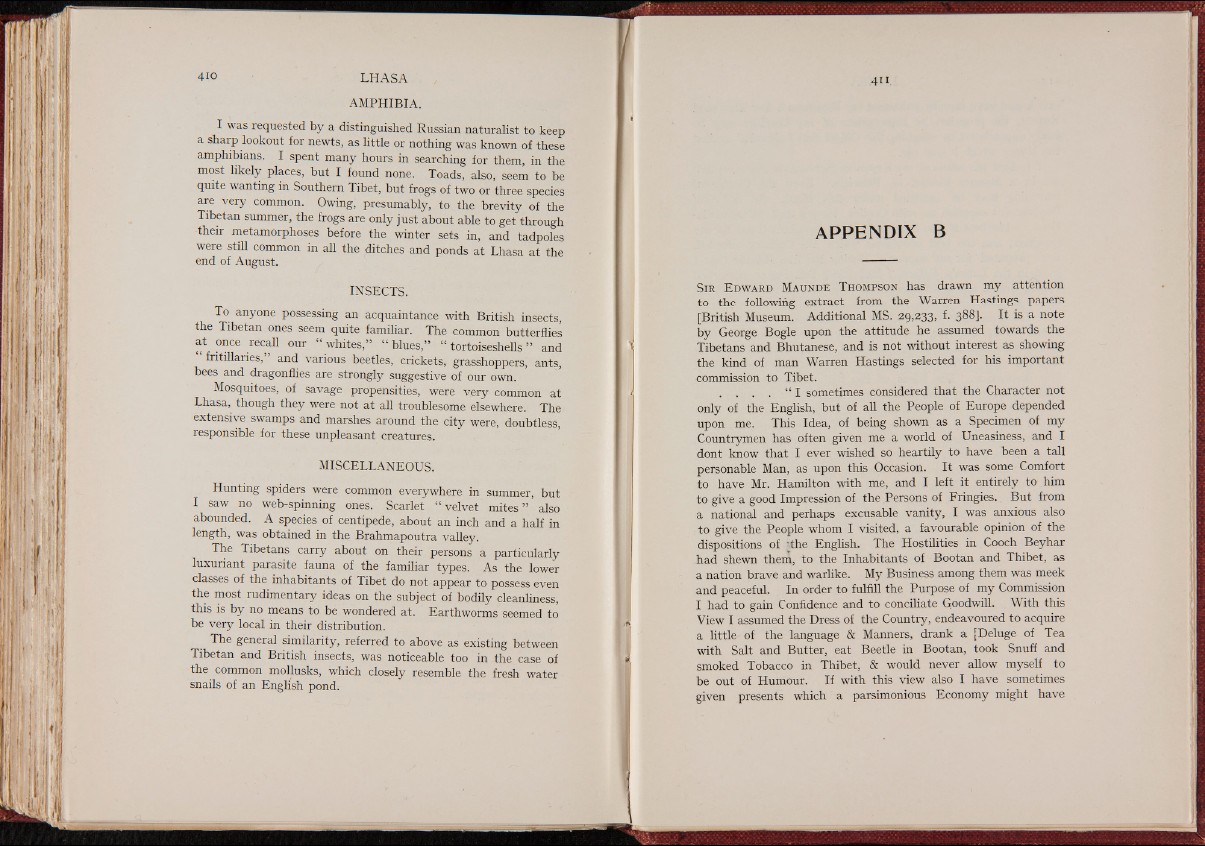
AMPHIBIA.
I was requested by a distinguished Russian naturalist to keep
a sharp lookout for newts, as little or nothing was known of these
amphibians. I spent many hours in searching for them, in the
most likely places, but I found none. Toads, also, seem to be
qmte wanting in Southern Tibet, but frogs of two or three species
are very common. Owing, presumably, to the brevity of the
Tibetan summer, the frogs are only just about able to get through
their metamorphoses before the winter sets in, and tadpoles
were still common in all the ditches and ponds at Lhasa at the
end of August.
INSECTS.
To anyone possessing an acquaintance with British insects,
the Tibetan ones seem quite familiar. The common butterflies
at once recall our | whites,” “ blues,” “ tortoiseshells ” and
fritillaries, and various beetles, crickets, grasshoppers, ants,
bees and dragonflies are strongly suggestive of our own.
Mosquitoes, of savage propensities, were very common at
Lhasa, though they were not at all troublesome elsewhere. The
extensive swamps and marshes around the city were, doubtless,
responsible for these unpleasant creatures.
MISCELLANEOUS.
II unt i ng spiders were common everywhere in summer, but
I saw no web-spinning ones. Scarlet “ velvet mites ” ’ also
abounded. A species of centipede, about an inch and a half in
length, was obtained in the Brahmapoutra valley.
The Tibetans carry about on their persons a particularly
luxuriant parasite fauna of the familiar types. As the lower
classes of the inhabitants of Tibet do not appear to possess even
the most rudimentary ideas on the subject of bodily cleanliness,
this is by no means to be wondered at. Earthworms seemed to
be very local in their distribution.
The general similarity, referred to above as existing between
Tibetan and British insects, was noticeable too in the case of
the common mollusks, which closely resemble the fresh water
snails of an English pond.
APPENDIX B
S i r E d w a r d M a u n d e T h o m p s o n has drawn my attention
to the following extract from the Warren Hastings papers
[British Museum. Additional MS. 29,233, f. 388]. It is a note
by George Bogle upon the attitude he assumed towards the
Tibetans and Bhutanese, and is not without interest as showing
the kind of man Warren Hastings selected for his important
commission to Tibet.
. . . . “ I sometimes considered that the Character not
only of the English, but of all the People of Europe depended
upon me. This Idea, of being shown as a Specimen of my
Countrymen has often given me a world of Uneasiness, and I
dont know that I ever wished so heartily to have been a tall
personable Man, as upon this Occasion. It was some Comfort
to have Mr. Hamilton with me, and I left it entirely to him
to give a good Impression of the Persons of Fringies. But from
a national and perhaps excusable vanity, I was anxious also
to give the People whom I visited, a favourable opinion of the
dispositions of 4 he English. The Hostilities in Cooch Beyhar
had shewn them, to the Inhabitants of Bootan and Thibet, as
a nation brave and warlike. My Business among them was meek
and peaceful. In order to fulfill the Purpose of my Commission
I had to gain Confidence and to conciliate Goodwill. With this
View I assumed the Dress of the Country, endeavoured to acquire
a little of the language & Manners, drank a [Deluge of Tea
with Salt and Butter, eat Beetle in Bootan, took Snuff and
smoked Tobacco in Thibet, & would never allow myself to
be out of Humour. If with this view also I have sometimes
given presents which a parsimonious Economy might have